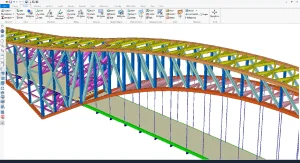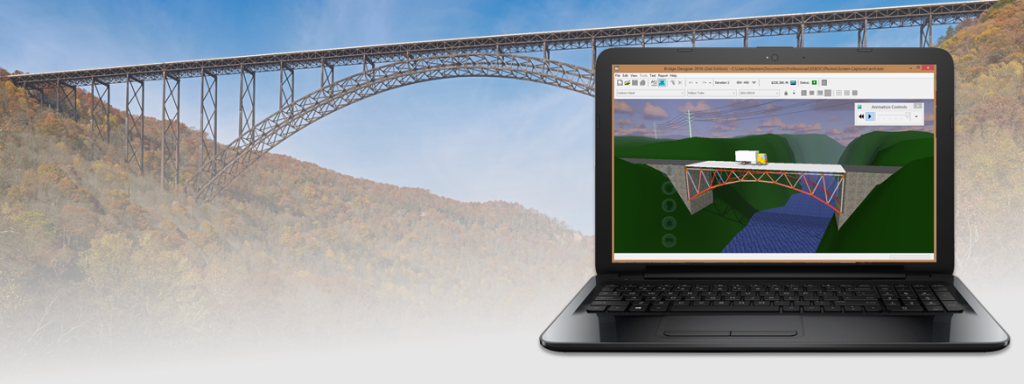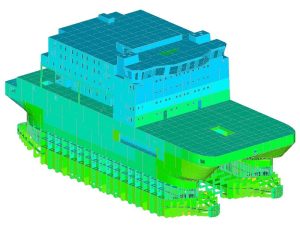Revolutionizing Structural Engineering Education
Civil and structural engineering education is evolving rapidly in the digital age. Traditional learning methods, such as textbooks, lectures, and diagrams, often fall short in preparing students for modern engineering challenges. Bridge builder software has emerged as a transformative tool that allows students, educators, and junior engineers to design, simulate, and test bridges in a safe virtual environment. By integrating principles of physics, material science, and structural engineering, these programs make learning interactive, engaging, and highly practical.
Whether for high school students exploring basic engineering concepts, university students specializing in civil engineering, or junior engineers refining their skills, bridge builder software offers significant educational value. This blog explores:
- Professional vs educational bridge builder tools
- Best apps for students and learners
- How gamification enhances learning
- Educational benefits in schools and universities
- Limitations and challenges
- Case studies and real-world applications
- Free vs paid platform comparisons
- Sample exercises and practical tips
Understanding Bridge Builder Software
Bridge builder software is designed to simulate real-world bridge construction, applying principles of physics and engineering in a digital environment. These tools allow users to build bridges, apply loads, analyze stress points, and optimize designs for stability and efficiency.
Key Features
- 3D Modeling: Users can create realistic bridge models with beams, trusses, cables, and supports.
- Load Simulation: Bridges are tested under various forces, including vehicles, wind, and environmental stressors.
- Stress Analysis: Critical areas of tension, compression, and potential failure are highlighted.
- Gamified Challenges: Many educational tools incorporate challenges, levels, and scoring to encourage creative problem-solving.
- Material Options: Some platforms allow selection of materials like steel, concrete, and composites to simulate realistic structural behavior.
- Instant Feedback: Students can see the immediate impact of design choices, promoting iterative learning.
Tip: Virtual simulation allows safe experimentation, reducing material costs and risks associated with real-world construction.
Professional vs Educational Tools
Bridge builder software can be broadly categorized into professional engineering software and educational/gamified platforms. Each serves different goals, audiences, and learning outcomes.
Professional Tools
Professional bridge design software is used by engineers for real-world construction projects. These tools are designed for precision, regulatory compliance, and collaboration.
Key Features of Professional Tools:
- Advanced Structural Analysis: Accurately calculates loads, deflection, and material properties.
- Regulatory Compliance: Ensures designs adhere to local, national, and international codes (AASHTO, Eurocodes).
- Material Selection: Supports various materials, including different steel grades and reinforced concrete.
- Team Collaboration: Multiple users can work on a single project, often integrated with CAD or BIM systems.
- Cost: High license fees, often requiring formal training or certification.
Examples: SAP2000, STAAD.Pro, Bentley Systems
Scenario: A junior engineer using STAAD.Pro must adhere strictly to building codes. The software ensures structural calculations meet safety standards, which is critical in professional practice but may be too complex for high school learners.
Educational Tools
Educational bridge builder software is designed for learning rather than executing actual construction. These tools simplify physics, provide interactive challenges, and encourage experimentation.
Key Features of Educational Tools:
- User-Friendly Interface: Drag-and-drop components for easy bridge construction.
- Gamification: Points, levels, and challenges motivate students to experiment.
- Affordable or Free: Accessible for schools and universities with limited budgets.
- Concept-Focused: Emphasizes tension, compression, load distribution, and stability.
- Learning Outcomes: Helps students internalize engineering principles through interactive play.
Examples: Bridge Constructor, Poly Bridge, Bridge Designer
Professional vs Educational Comparison Table
| Feature | Professional Tools | Educational Tools |
| Purpose | Real-world bridge construction | Learning and engagement |
| Physics Accuracy | High, precise | Simplified for understanding |
| Complexity | Requires training | Beginner-friendly |
| Cost | Expensive | Free or low-cost |
| Collaboration | Team projects, CAD/BIM integration | Optional multiplayer/class challenges |
| Compliance | Meets building codes | Focus on principles |
| Material Options | Wide variety | Limited/basic materials |
| Target Users | Professional engineers | Students, teachers, juniors |
| Feedback | Detailed metrics and reports | Immediate visual/interactive feedback |
Pro Tip: Students can start with educational software and gradually transition to professional tools as skills and career demands grow.
Best Bridge Builder Apps for Students
Several applications have emerged as popular choices for students, educators, and beginners in structural engineering. Here’s a detailed look at the top platforms:
1. Bridge Constructor
- Platform: PC, Mobile
- Highlights: Physics-based mechanics, realistic materials, gamified challenges
- Learning Outcomes: Teaches load distribution, structural integrity, and efficient use of materials
- Pro Tip: Build multiple versions of the same bridge to explore how minor changes affect stability
2. Poly Bridge
- Platform: PC, Console
- Highlights: Creative freedom, realistic simulation, challenging puzzles
- Learning Outcomes: Encourages iterative problem-solving, analytical thinking, and creative design
- Pro Tip: Use trial and error to test unconventional designs and analyze why some fail
3. Bridge Designer
- Platform: PC
- Highlights: Classic educational software used in classrooms
- Learning Outcomes: Introduces tension, compression, support types, and bridge mechanics
- Pro Tip: Start with simple designs, gradually increasing complexity to build confidence
4. SimplePhysics
- Platform: Mobile
- Highlights: Physics simulation beyond bridges, intuitive interface
- Learning Outcomes: Understanding of forces, balance, and stability
5. LEGO Bridge Builder Apps
- Platform: Mobile
- Highlights: Combines play and learning for younger students
- Learning Outcomes: Introduces basic structural engineering principles in a fun and interactive way
Student Tips for Using Bridge Builder Apps
- Start with basic challenges to understand load distribution.
- Analyze failed designs to identify weak points.
- Compare multiple solutions to improve efficiency.
- Use apps as part of team projects to enhance collaboration.
- Document lessons learned from each simulation for reflection.
How Gamification Enhances Learning
Gamification, the application of game elements in education, is a core component of many bridge builder tools.
Benefits
- Increased Engagement: Students are more motivated to complete challenges.
- Improved Problem-Solving: Reward systems encourage creative solutions.
- Experiential Learning: Immediate feedback helps reinforce concepts.
- Collaboration: Multiplayer or classroom challenges build teamwork skills
Example: In Poly Bridge, students are tasked with building a bridge that can support a heavy vehicle using limited materials. Bridges may fail, prompting analysis and redesign. Over time, this iterative process reinforces lessons about tension, compression, and structural stability.
Research Insight: Studies show gamified engineering education improves retention rates by 30–50% compared to traditional lecture-based methods.
Educational Value in Schools and Universities
Bridge builder software provides measurable benefits for students:
- Conceptual Understanding: Students grasp complex engineering topics faster than through lectures alone.
- Safe Experimentation: Virtual bridges allow multiple iterations without safety risks or material costs.
- Career Exposure: Early insight into civil engineering roles and responsibilities.
- Curriculum Integration: Can be incorporated into physics, mathematics, and engineering courses.
- Skill Development: Promotes critical thinking, creativity, analytical skills, and problem-solving.
Classroom Example: Students might be assigned to design a bridge supporting a virtual load of 500 tons using limited materials. They test their designs virtually, refine them, and present results to peers. This combines theory, practice, and communication skills.
Limitations of Bridge Builder Software
Despite benefits, software has constraints:
- Simplified Physics: Many apps cannot replicate all real-world forces.
- Limited Material Options: Advanced steel/concrete variations may not be available.
- Regulatory Oversight: Educational software often ignores building codes.
- Dependency on Digital Skills: Students must navigate software effectively.
- No Hands-On Experience: Virtual simulations cannot replace actual construction experience.
Mitigation: Combine software use with real-world labs, workshops, or site visits to provide practical exposure.
Case Studies
Case Study 1: Dubai Construction Firm
- Objective: Train junior engineers using bridge builder software.
- Implementation: Poly Bridge and Bridge Constructor used for simulation exercises.
- Results:
- Faster understanding of structural principles
- Innovative, efficient designs
- Objective metrics for performance evaluation
- Enhanced teamwork and collaboration
Case Study 2: University Engineering Program
- Objective: Teach first-year students bridge mechanics.
- Implementation: LEGO Bridge Builder Apps and Bridge Designer used for progressive learning.
- Results:
- Increased engagement and retention
- Improved conceptual understanding
- Encouraged critical thinking and iterative problem-solving
Case Study 3: High School STEM Program
- Objective: Introduce engineering principles to younger students
- Implementation: Gamified bridge-building challenges using free apps
- Results: Students built creative bridges, learned collaboration, and developed problem-solving skills
Free vs Paid Bridge Builder Platforms
| Platform Type | Advantages | Examples | Best For |
| Free | Accessible, encourages experimentation, beginner-friendly | Bridge Designer, LEGO Bridge Apps | Schools, beginners |
| Paid | Advanced physics, realistic materials, analytics, teacher support | Poly Bridge Pro, Bridge Constructor Professional | Universities, professional training |
Recommendation: Start with free apps to learn fundamentals, then upgrade to paid platforms for advanced challenges, analytics, and professional readiness.
Sample Exercises for Students
Challenge: Build a bridge supporting 1,000 tons using only limited materials.
Steps:
- Plan the bridge design using trusses and supports.
- Simulate load conditions in software.
- Identify points of failure and redesign.
- Optimize material usage for cost and efficiency.
- Present results with visual simulation screenshots.
Learning Outcomes: Understanding of load distribution, tension, compression, and iterative design.
Common Mistakes:
- Overloading supports
- Ignoring tension forces
- Using inefficient truss patterns
Future of Bridge Builder Software

Emerging technologies promise more advanced educational tools:
- AI-Assisted Design: Suggests optimal designs based on load calculations.
- Virtual Reality (VR): Walk through bridges to inspect stress points.
- Cloud-Based Collaboration: Teams worldwide can co-design and test bridges.
- Adaptive Learning: Software tailors challenges to individual skill levels.
FAQs
1. What is the best bridge builder software for beginners?
Bridge Designer and LEGO Bridge Apps are ideal starting points.
- Can these apps replace real-world training?
- They complement hands-on learning but cannot replace real-world experience.
- How can software be integrated into classrooms?
- Assign projects aligned with curriculum, encourage teamwork, and review outcomes in discussions.
Conclusion
Bridge builder software is transforming engineering education by combining virtual simulation, gamification, and hands-on learning. Students gain:
- Practical understanding of bridge mechanics
- Increased engagement and problem-solving skills
- Safe experimentation with low-cost materials




